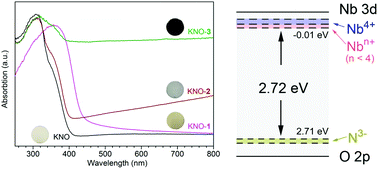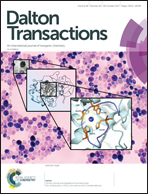The impact of nitrogen doping and reduced-niobium self-doping on the photocatalytic activity of ultra-thin Nb3O8− nanosheets†
Abstract
Nitrogen doping via high-temperature ammonization is a frequently used strategy to extend the light harvesting capacity of wide-bandgap catalysts in the visible region. Under such a reductive atmosphere, the reduction of transition metals is supposed to occur, however, this has not been thoroughly studied yet. Here, by combining chemically-controlled doping and subsequent liquid exfoliation, ultra-thin [Nb3O8]− nanosheets with separate N doping, reduced-Nb doping and N/reduced-Nb codoping were fabricated for comparative studies on the doping effect for photocatalytic hydrogen evolution. Layered KNb3O8 was used as the starting material and the above-mentioned three doping conditions were achieved by high-temperature treatment with urea, hydrogen and ammonia, respectively. The morphology, crystal and electronic structures, and the catalytic activity of the products were characterized thoroughly by means of TEM, AFM, XRD, XPS, EPR, absorption spectroscopy and photocatalytic hydrogen evolution. Significantly, the black N/reduced-Nb co-doped monolayer [Nb3O8]− nanosheets exhibit the mostly enhanced photocatalytic hydrogen generation rate, indicating a synergistic doping effect of the multiple chemical-design strategy. The modified electronic structure of [Nb3O8]− nanosheets and the role of exotic dopants in bandgap narrowing are put forward for the rational design of better photocatalysts with reduced-metal self-doping.



 Please wait while we load your content...
Please wait while we load your content...